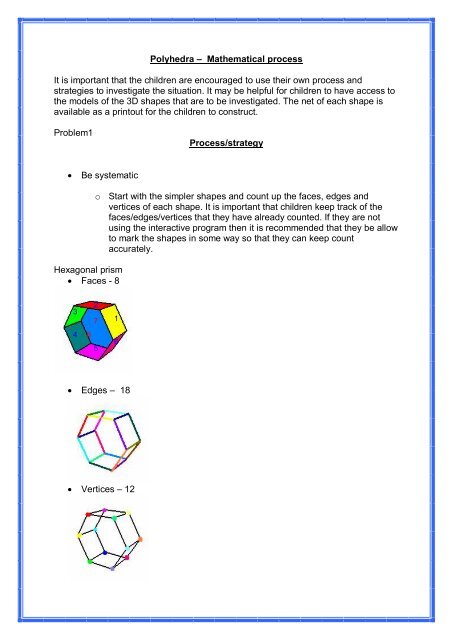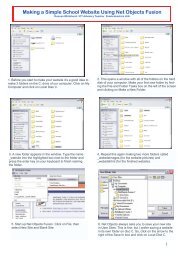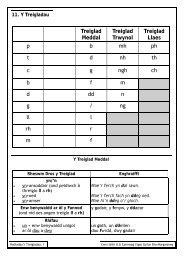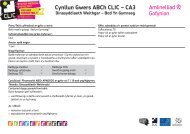Polyhedra – Mathematical process It is important that the children ...
Polyhedra – Mathematical process It is important that the children ...
Polyhedra – Mathematical process It is important that the children ...
Create successful ePaper yourself
Turn your PDF publications into a flip-book with our unique Google optimized e-Paper software.
<strong>Polyhedra</strong> <strong>–</strong> <strong>Ma<strong>the</strong>matical</strong> <strong>process</strong><br />
<strong>It</strong> <strong>is</strong> <strong>important</strong> <strong>that</strong> <strong>the</strong> <strong>children</strong> are encouraged to use <strong>the</strong>ir own <strong>process</strong> and<br />
strategies to investigate <strong>the</strong> situation. <strong>It</strong> may be helpful for <strong>children</strong> to have access to<br />
<strong>the</strong> models of <strong>the</strong> 3D shapes <strong>that</strong> are to be investigated. The net of each shape <strong>is</strong><br />
available as a printout for <strong>the</strong> <strong>children</strong> to construct.<br />
Problem1<br />
• Be systematic<br />
Hexagonal pr<strong>is</strong>m<br />
• Faces 8<br />
3<br />
4<br />
8<br />
Process/strategy<br />
o Start with <strong>the</strong> simpler shapes and count up <strong>the</strong> faces, edges and<br />
vertices of each shape. <strong>It</strong> <strong>is</strong> <strong>important</strong> <strong>that</strong> <strong>children</strong> keep track of <strong>the</strong><br />
faces/edges/vertices <strong>that</strong> <strong>the</strong>y have already counted. If <strong>the</strong>y are not<br />
using <strong>the</strong> interactive program <strong>the</strong>n it <strong>is</strong> recommended <strong>that</strong> <strong>the</strong>y be allow<br />
to mark <strong>the</strong> shapes in some way so <strong>that</strong> <strong>the</strong>y can keep count<br />
accurately.<br />
2<br />
7<br />
5<br />
1<br />
6<br />
• Edges <strong>–</strong> 18<br />
• Vertices <strong>–</strong> 12
• Tabulate results<br />
Shape Number of<br />
faces<br />
Cube<br />
Cuboid<br />
Number of<br />
vertices<br />
Number of<br />
edges<br />
6 8 12<br />
6 8 12<br />
Triangular<br />
pr<strong>is</strong>m 5 6 9<br />
Hexagonal<br />
pr<strong>is</strong>m 8 12 18<br />
Square based<br />
pyramid 4 4 6<br />
Hexagonal<br />
based pyramid 7 7 12<br />
Tetrahedron<br />
Octahedron<br />
4 4 6<br />
8 6 12<br />
Dodecahedron 12 20 30<br />
Icosahedron<br />
• Look for a pattern in results<br />
20 12 30<br />
If <strong>the</strong> results have been tabulated in th<strong>is</strong> way <strong>the</strong>n <strong>the</strong> relationship between <strong>the</strong><br />
faces, vertices and edges should be fairly easy for <strong>the</strong> <strong>children</strong> to identify. (The<br />
less able worksheet <strong>is</strong> worded in a way <strong>that</strong> leads <strong>the</strong>m towards finding <strong>the</strong><br />
relationship)<br />
Cube<br />
Cuboid<br />
Triangular pr<strong>is</strong>m<br />
Hexagonal pr<strong>is</strong>m<br />
6 + 8 2 = 12<br />
6 8 12<br />
5 + 6 2 = 9<br />
8 12 18<br />
The pupils should<br />
notice <strong>that</strong> <strong>the</strong> number<br />
of edges can be found<br />
by adding toge<strong>the</strong>r <strong>the</strong><br />
faces and vertices and<br />
<strong>the</strong>n subtracting 2.
Solutions<br />
• To find <strong>the</strong> number of edges add <strong>the</strong> number of faces and <strong>the</strong> number of<br />
vertices and <strong>the</strong>n subtract 2.<br />
• NB Children will most probably use specific values to explain <strong>the</strong>ir logic, not a<br />
general<strong>is</strong>ed one.<br />
• To find <strong>the</strong> general<strong>is</strong>ed statement;<br />
Let <strong>the</strong> faces = f<br />
Let <strong>the</strong> vertices = v<br />
Let <strong>the</strong> edges = e<br />
So if <strong>the</strong> number of edges <strong>is</strong> equal to <strong>the</strong> number of faces added to <strong>the</strong><br />
number of vertices subtract 2 we can write th<strong>is</strong> as<br />
(f + v) <strong>–</strong> 2 = e<br />
• To extend <strong>the</strong> learning of more able <strong>children</strong> you may ask <strong>the</strong>m to find ei<strong>the</strong>r<br />
<strong>the</strong> number of faces or vertices if <strong>the</strong>y have <strong>the</strong> data for <strong>the</strong> o<strong>the</strong>r two.<br />
• Number of faces<br />
Th<strong>is</strong> could be tackled by looking at <strong>the</strong> table of results<br />
Shape Number of<br />
edges<br />
Cube<br />
Number of<br />
vertices<br />
Number of<br />
faces<br />
12 8 6<br />
Triangular<br />
pr<strong>is</strong>m 9 6 5<br />
Hexagonal<br />
pr<strong>is</strong>m 18 12 8<br />
<strong>It</strong> could also be tackled by rearranging <strong>the</strong> formula<br />
(f + v) <strong>–</strong> 2 = e<br />
f <strong>–</strong> 2 = e v (taking v away from both sides)<br />
f = e + v + 2 (adding 2 to both sides)<br />
Our general term <strong>is</strong> f = (e v) + 2<br />
+ 2 =<br />
They should notice<br />
<strong>that</strong> <strong>the</strong> number of<br />
faces can be found<br />
by taking <strong>the</strong> number<br />
of vertices away<br />
from <strong>the</strong> number of<br />
edges and adding 2.
• Number of vertices<br />
Th<strong>is</strong> could be tackled by looking at <strong>the</strong> table of results<br />
Shape Number of<br />
edges<br />
Cube<br />
Number of<br />
faces<br />
Number of<br />
vertices<br />
12 6 8<br />
Triangular<br />
pr<strong>is</strong>m 9 5 6<br />
Hexagonal<br />
pr<strong>is</strong>m 18 8 12<br />
<strong>It</strong> could also be tackled by rearranging <strong>the</strong> formula<br />
(f + v) <strong>–</strong> 2 = e<br />
v <strong>–</strong> 2 = e f (taking f away from both sides)<br />
v = e + f + 2 (adding 2 to both sides)<br />
Our general term <strong>is</strong> v = (e f) + 2<br />
Problem 2<br />
<br />
+ 2 =<br />
Process/Strategy<br />
They should notice<br />
<strong>that</strong> <strong>the</strong> number of<br />
vertices can be<br />
found by taking <strong>the</strong><br />
number of faces<br />
away from <strong>the</strong><br />
number of edges<br />
and adding 2.<br />
• Be systematic<br />
NB <strong>It</strong> should be noted <strong>that</strong> <strong>the</strong>se results are based on <strong>the</strong> use of <strong>the</strong> 3D shapes<br />
<strong>that</strong> can be constructed from <strong>the</strong> nets within <strong>the</strong> pack. The results will vary if you<br />
use different 3D shapes (e.g. our pentagonal pr<strong>is</strong>m <strong>is</strong> made up of pentagons and<br />
squares. You may have a pentagonal pr<strong>is</strong>m <strong>that</strong> <strong>is</strong> made up of pentagons and<br />
rectangles.)<br />
Each of <strong>the</strong> 3D shapes needs to be studied and <strong>the</strong> name of <strong>the</strong> different 2D<br />
shapes <strong>that</strong> make up its faces need to be recorded. The <strong>children</strong> could use <strong>the</strong><br />
interactive program to study <strong>the</strong> shapes or <strong>the</strong> nets of <strong>the</strong> shapes can be printed<br />
out and constructed.<br />
5<br />
4 3<br />
1<br />
1<br />
2<br />
Pentagonal based pyramid <strong>is</strong> made up of 5 triangles<br />
and 1 pentagon.
• Tabulate results<br />
Shape Triangular<br />
face<br />
Square<br />
face<br />
Look for shapes <strong>that</strong> share a face<br />
Rectangular<br />
face<br />
Pentagonal<br />
face<br />
Hexagonal<br />
face<br />
Cube × × × ×<br />
Cuboid × × ×<br />
Square<br />
based<br />
pyramid<br />
Pentagonal<br />
based<br />
pyramid<br />
Hexagonal<br />
based<br />
pyramid<br />
× × ×<br />
× × ×<br />
× × × <br />
Triangular<br />
pr<strong>is</strong>m × × ×<br />
Pentagonal<br />
pr<strong>is</strong>m × × ×<br />
Hexagonal<br />
pr<strong>is</strong>m × × × <br />
Triangular<br />
face<br />
Square based<br />
pyramid<br />
Pentagonal<br />
based<br />
pyramid<br />
Hexagonal<br />
based<br />
pyramid<br />
Triangular<br />
pr<strong>is</strong>m<br />
Square<br />
face<br />
Cube<br />
Cuboid<br />
Square<br />
based<br />
pyramid<br />
Pentagonal<br />
pr<strong>is</strong>m<br />
Triangular<br />
pr<strong>is</strong>m<br />
Rectangular<br />
face<br />
Cuboid<br />
Hexagonal<br />
pr<strong>is</strong>m<br />
Pentagonal<br />
face<br />
Pentagonal<br />
based<br />
pyramid<br />
Pentagonal<br />
pr<strong>is</strong>m<br />
Hexagonal<br />
face<br />
Hexagonal<br />
based<br />
pyramid<br />
Hexagonal<br />
pr<strong>is</strong>m
Making branching trees for each shape may help<br />
Follow <strong>the</strong> lines of <strong>the</strong> branching tree to complete <strong>the</strong> polyhedral chain<br />
Cube<br />
Square based<br />
pyramid<br />
Pentagonal<br />
pr<strong>is</strong>m<br />
Cube<br />
Cuboid Square based<br />
pyramid<br />
Hexagonal<br />
pr<strong>is</strong>m<br />
Pentagonal<br />
based<br />
pyramid<br />
Hexagonal<br />
based<br />
pyramid<br />
Cuboid<br />
Triangular<br />
pr<strong>is</strong>m<br />
Pentagonal<br />
pr<strong>is</strong>m<br />
Triangular<br />
pr<strong>is</strong>m<br />
Hexagonal<br />
pr<strong>is</strong>m<br />
Pentagonal<br />
based<br />
pyramid<br />
Hexagonal<br />
based<br />
pyramid<br />
There are many solutions to <strong>the</strong> polyhedral chain. The <strong>children</strong> should be<br />
encouraged to adopt <strong>the</strong>ir own strategies and explain <strong>the</strong>ir reasoning.
Some possible solutions are as follows:<br />
Square based pyramid <strong>–</strong> Pentagonal based pyramid Pentagonal pr<strong>is</strong>m Cube<br />
<strong>–</strong> Cuboid <strong>–</strong> Hexagonal pr<strong>is</strong>m <strong>–</strong> Hexagonal based pyramid <strong>–</strong>Triangular pr<strong>is</strong>m <strong>–</strong><br />
Square based pyramid<br />
Hexagonal based pyramid <strong>–</strong> Square based pyramid <strong>–</strong> Triangular pr<strong>is</strong>m <strong>–</strong><br />
Pentagonal based pyramid Pentagonal pr<strong>is</strong>m <strong>–</strong> Cube <strong>–</strong> Cuboid <strong>–</strong>Hexagonal<br />
pr<strong>is</strong>m Hexagonal based pyramid<br />
Pentagonal pr<strong>is</strong>m <strong>–</strong> Cuboid <strong>–</strong> Hexagonal pr<strong>is</strong>m <strong>–</strong> Hexagonal based pyramid <strong>–</strong><br />
Pentagonal based pyramid <strong>–</strong> Triangular pr<strong>is</strong>m <strong>–</strong>Cube <strong>–</strong>Square based pyramid <strong>–</strong><br />
Pentagonal pr<strong>is</strong>m<br />
Triangular pr<strong>is</strong>m <strong>–</strong> Hexagonal based pyramid <strong>–</strong> Hexagonal pr<strong>is</strong>m <strong>–</strong> Cuboid <strong>–</strong><br />
Cube Pentagonal pr<strong>is</strong>m <strong>–</strong>Pentagonal based pyramid <strong>–</strong> Square based pyramid <strong>–</strong><br />
Triangular pr<strong>is</strong>m








